How to Care for a Philodendron Plant: A Detailed Guide
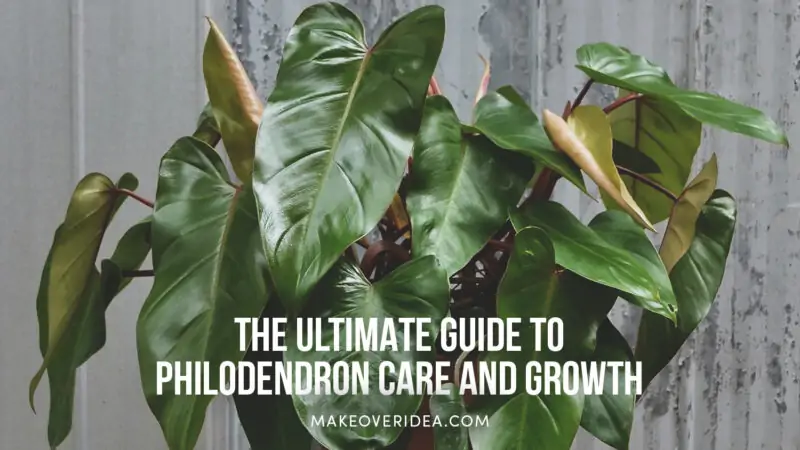
Welcome to our ultimate guide on how to care for a philodendron plant! Families have adorned their homes for millennia with these magnificent indoor plants: lush foliage and low maintenance requirements make philodendrons a popular choice for all lovers of houseplants. We will thoroughly discuss this botanical family, its history, and how to pick the best plant for your environment.
Philodendron Overview
The family Araceae includes a wide range of tropical plants, including philodendrons. These plants have over 400 species and come in various sizes, shapes, and colors. There are two types of philodendrons: namely, vining and non-climbing varieties. Non-climbing plants often have a more compact, bushy appearance, while climbing species are recognized for their vining growth habit.
Philodendron Varieties
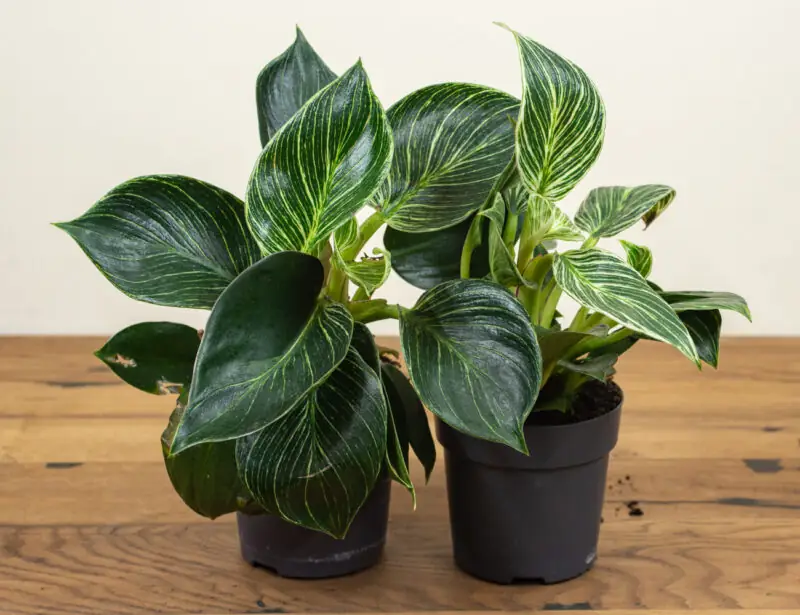
These plants come in many different varieties, each with its own special traits. Other well-liked types include:
- Heartleaf Philodendron (Philodendron hederaceum) — This plant is an excellent option for hanging baskets or climbing on a support and is distinguished by its heart-shaped leaves.
- Monstera Deliciosa: This plant, which is closely related to the philodendron family and has broad, fenestrated leaves, is sometimes mistaken for a real philodendron.
- P. Birkin: The lovely variegated leaves of this small plant include white pinstripe patterns.
- A climbing cultivar of this plant called “Brasil” has brilliant green leaves with a yellow variegation running through the middle of them.
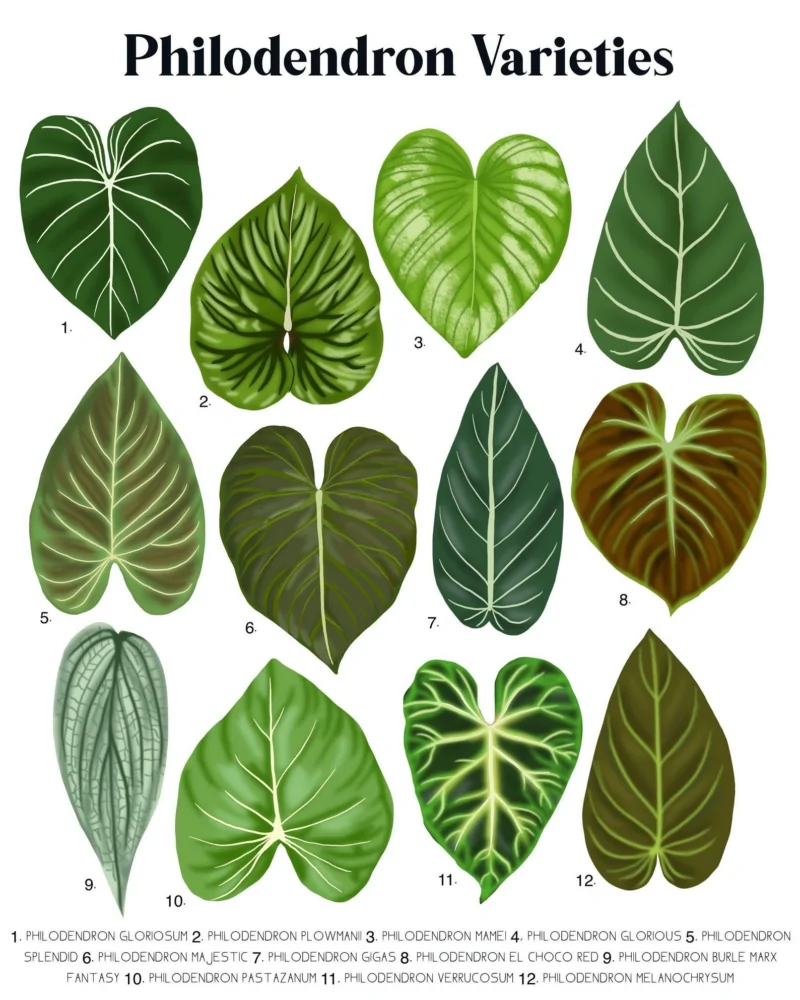
History and Origin
These plants are indigenous to Central and South America’s tropical areas, where they quickly propagate in humid conditions like rainforests. Since the 19th century, they have been grown for their ornamental value, and they are still a well-liked option for indoor gardens all over the world.
Deciding Upon the Best Variety for Your Environment
The ideal philodendron variety for your house will rely on a number of elements, including the amount of room you have, the amount of light it receives, and your particular preferences.
Assessing Your Environment’s Lighting
Assess the area first before putting your newly bought plant there. Non-climbing cultivars often keep more compact, whereas climbing varieties can grow rather large and may need more space. Furthermore, take into account the lighting in your area. Most of these plants can withstand lower light levels but prefer indirect (yet bright) light to grow.
Common Types of Philodendron
Now that you are more aware of your surroundings and the lighting let’s look at some common plants that belong to this family:
- P. Birkin, Moonlight Philodendron, or P. Xanadu is suitable for tiny settings.
- Heartleaf Philodendron, Velvet-Leaf Philodendron, or P. Imperial Green are suitable plants for low light circumstances.
- Monstera Delicias, P. Selloum, or P. Squamiferum are suitable plants for vast spaces.
- P. Mamei, P. Gloriosum, or P. Pink Princess are good choices for unusual foliage.
To select the type that best satisfies your requirements and aesthetic preferences, take into account the development patterns and appearance of each variety.
Maintenance and Care for Philodendron
For this plant to remain strong and healthy, proper maintenance is necessary. The fundamentals of watering, light and temperature requirements, soil and fertilizer, and pruning and trimming will all be covered in this part.
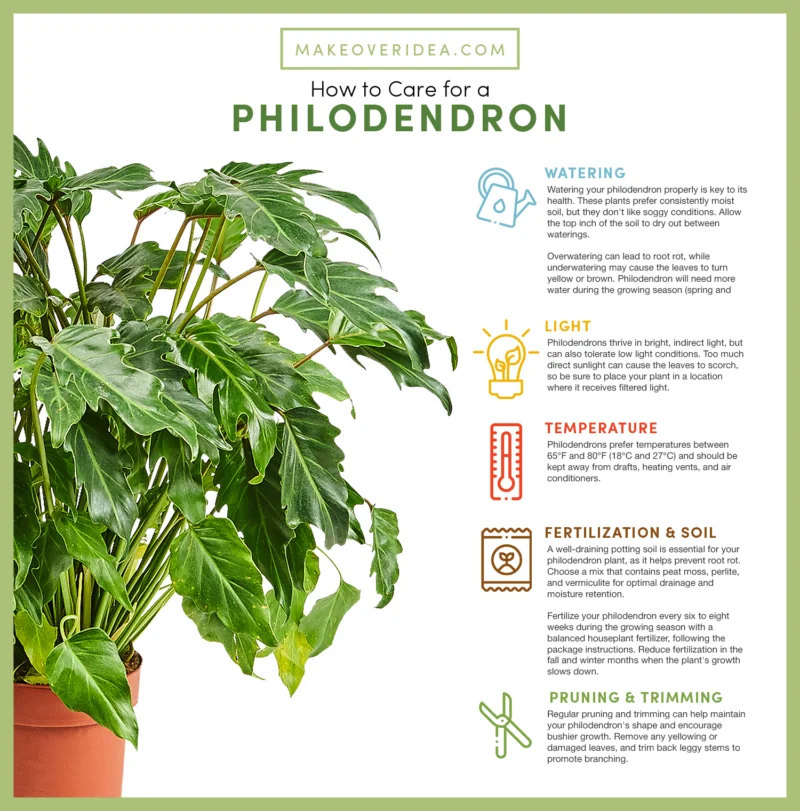
Watering Conditions
The health of your plant depends on how well you water it. These plants do not favor damp circumstances; instead, they demand constantly moist soil. Between waterings, let the top inch of the soil dry out. Underwatering can cause the leaves to turn yellow or brown while overwatering might result in root rot. Water the plant more often during the growing season (spring and summer) and less throughout the fall and winter, so adjust your watering schedule accordingly.
Requirements for Light and Temperature
These plants can withstand low light levels and flourish in direct, bright light. Place your plant where it will receive filtered light because too much direct sunshine might cause the leaves to burn. Philodendron houseplants should be maintained away from drafts, heating vents, and air conditioners because they prefer temperatures between 65°F and 80°F (18°C and 27°C).
Fertilization and Soil
Your plant needs well-draining potting soil since it prevents root rot. For the best drainage and moisture absorption, use a mix of peat moss, perlite, and vermiculite. Throughout the growing season, fertilize your plant every six to eight weeks with a balanced houseplant fertilizer by following the directions on the container. When the plant’s growth slows in the fall and winter, fertilizer should be reduced.
Trimming & Pruning
Care requirements for these plants include frequent pruning and trimming, as they can promote bushier growth and keep your beautiful plant in good shape. Trim any damaged or yellowing leaves and leggy stems to encourage branching. For a more upright growth habit, climbing varieties can be trained to grow on a support such as a moss pole or trellis.
Growing Philodendrons: Propagation
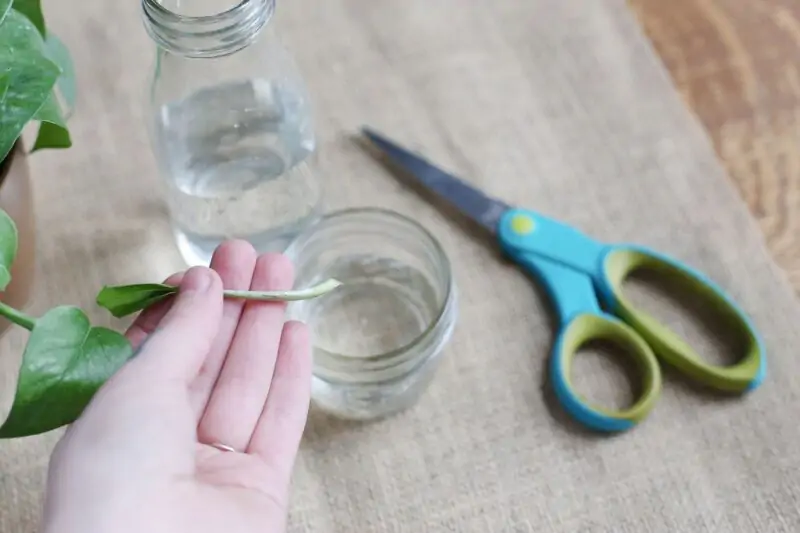
Philodendron propagation is a simple and pleasant process. The two most prevalent techniques are stem cuttings and air layering, and you can grow new plants from your existing ones using either technique.
Stem Cuttings
This approach is both easy and quick. Follow these steps to accomplish this:
- Choose a stem that is healthy and has at least two leaves and a node (the point where a leaf attaches to the stem).
- Use clean, sharp scissors to cut the stem just below the node.
- After removing the bottom leaf, only the top one or two leaves should remain on the cutting.
- The cutting should be placed in a container with water so that the node is immersed, but the leaves do not come in contact with the liquid.
- Change the water in the jar every few days and place it in an area with bright, indirect light.
- You should start to notice roots forming in a few weeks. Transplant the cutting into a pot with well-draining fresh soil of potting mix once the roots are about an inch long.
Air Layering
You can also propagate this plant by air layering, best suited for species with more giant, woody stems. Here is how you do it:
- Make a modest upward cut immediately below the leaf node on a healthy stem with a leaf node about one-third of the way through the stem.
- Place a toothpick or small wooden stick inside to keep the cut open.
- To hold the moss in place and preserve humidity, wrap the cut area in moist sphagnum moss and cover it with plastic wrap. The ends should be fastened with twist ties or rubber bands.
- Hang the wrapped stem from a bright, indirect light source, and check the moss occasionally to ensure it’s still moist. Mist it with water if it starts to dry out.
- Inside the moss, roots should begin to grow after a few weeks. Cut the stem below the freshly rooted section once the roots are established.
- After carefully removing the plastic wrap and moss, move the new plant into a pot filled with potting soil that drains quickly.
You’ll be well on your way to successfully growing and appreciating your plant according to these care and propagation instructions. With their thick leaves and air-purifying qualities, these adaptable and beautiful houseplants can significantly improve your environment both indoors and outdoors.
Typical Pests and Illnesses of the Philodendron
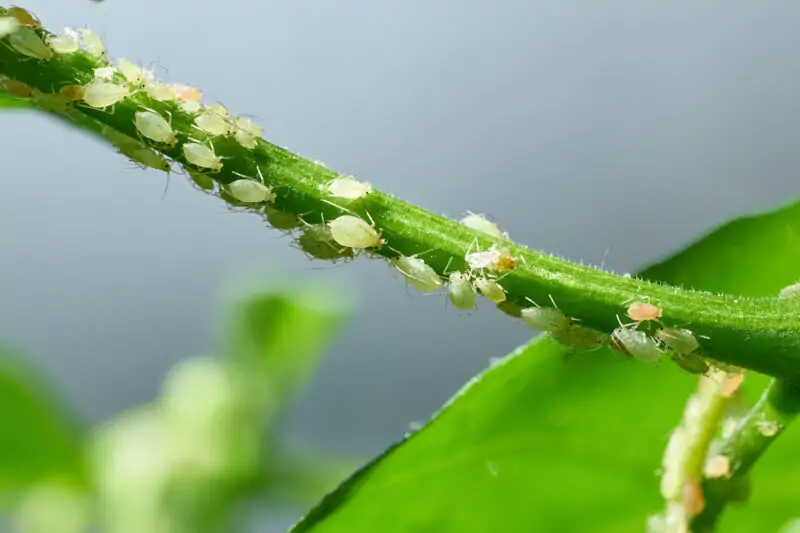
These plants are subject to pests and diseases, just like any other indoor plant. To keep your plant healthy, it’s critical to spot these problems early and take the right action.
Recognizing Insects and Illness
Spider mites, aphids, mealybugs, and scale insects are a few typical pests that may harm plants of this family. Discolored, curled, or sticky leaves, as well as the presence of tiny insects or webbing on the plant, can all be indicators of pest infestation.
Root rot, which is brought on by excessive watering and poor drainage, and bacterial or fungal leaf spot infections, which produce brown, black, or yellow spots on the leaves, are two diseases that can harm these plants.
Protection and Care
Use proper plant care techniques, such as watering, fertilizing, and preserving ideal light and temperature conditions, to ward off pests and diseases. If you see any evidence of an infestation or illness, inspect your plant frequently and segregate it from other plants.
You might try wiping the leaves with a solution of soapy water, insecticidal soap, or neem oil for pest management. You might need to use a systemic insecticide in extreme circumstances. Remove afflicted leaves and enhance care practices to address ailments. In some circumstances, a fungicide might be required.
Using Philodendrons as Decorations
The stunning addition of these tall and wide plants will benefit both your indoor and outdoor areas. They are an excellent option for a variety of décor ideas due to their beautiful large leaves and versatility.
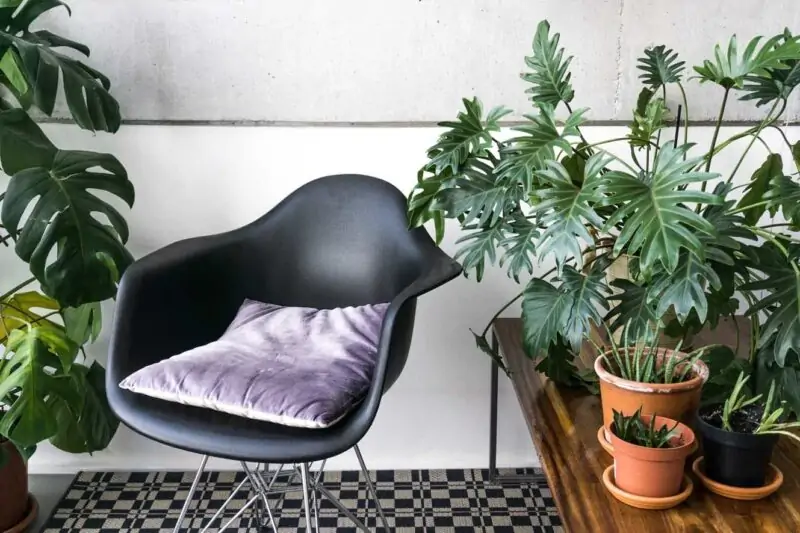
Interior Design Concepts
Philodendrons can be utilized to provide your indoor living environment with a little bit of greenery. Think about the following concepts:
- Create a focal point in your living room by positioning a large-leafed plant, such as the Monstera deliciosa, in a unique pot.
- A climbing philodendron, like the heartleaf variety, can be hung from a hook in the ceiling or from a hanging basket close to a window that gets plenty of light.
- You can also teach a climbing philodendron to climb a moss pole or trellis to give your space more height and visual intrigue.
Ideas for Outdoor Landscaping
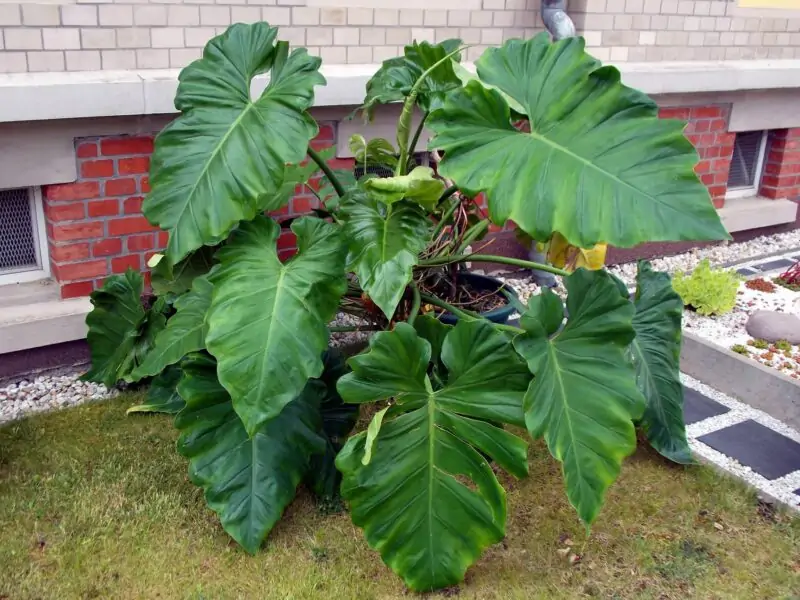
These plants can be a wonderful addition to your garden if you live in a warm area where they can be grown outside. Here are a few suggestions for adding them to your landscape:
- In shaded places, use vining varieties as a ground cover so they can expand and cover any barren spots.
- Climbing cultivars should be planted close to a fence, trellis, or pergola so they can form a living wall or canopy.
- For aesthetic appeal and texture, blend large-leaved and vining cultivars in a garden bed with a tropical theme.
- Philodendrons may add a lush, tropical feel and a sense of connection to nature to any indoor or outdoor décor, effectively elevating the area.
Commonly Asked Philodendron Questions
Several questions can arise regarding philodendron grow and care, particularly for novice plant owners. Here are some of the most typical queries and their responses to assist you in maintaining a happy and healthy plant.
The calcium oxalate crystals found in these plants can be hazardous to animals if consumed. Contact your vet right away if you think your pet may have chewed on a philodendron.
The variety and growing circumstances of these plants affect their rate of growth. They often grow quickly, with some vining species reaching heights of up to 12 inches each month under ideal circumstances.
The majority of these plants can survive in low light, but their development may be slower, and their leaves may lose some of their vibrancy. It’s crucial to remember that no plant can endure such indoor conditions as total darkness.
Depending on how much light it needs, this plant can grow in many locations. The majority of these plants are sensitive to direct sun rays, so it is crucial that you avoid exposing the plant to the sun. What it needs is strong yet indirect light, making it a good idea to place them close to a north or east-facing window. Avoid direct sunlight since it may burn the foliage.
The size of the plant, the pot, and the location all affect how frequently philodendrons need to be watered. Typically, water your philodendron when the top inch of soil is dry to the touch. Root rot can result from overwatering.
Conclusion
Learning how to care for a philodendron plant is key to maintaining a healthy and thriving specimen. With the proper care for your philodendron it can become a stunning addition to your interior or outdoor environment. Don’t forget to select the best kind for your environment, give it the necessary amount of water and light, and keep an eye out for pests and illnesses. As you gain expertise, you’ll be able to appreciate the lush greenery and tropical feel that these plants add to your home or yard.